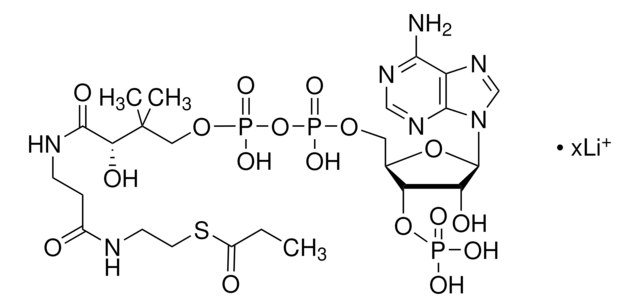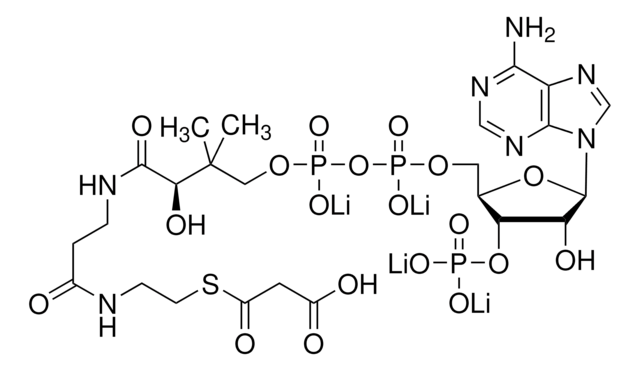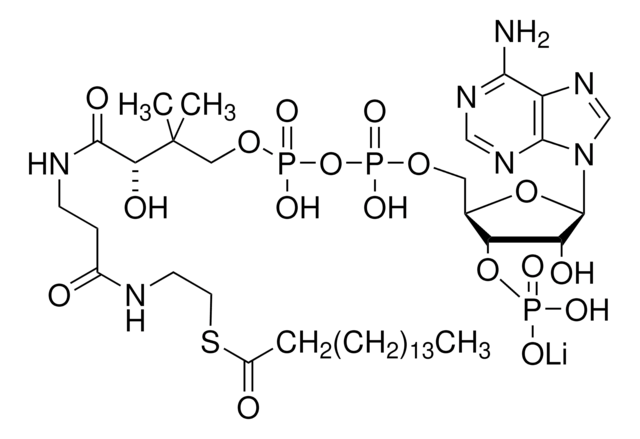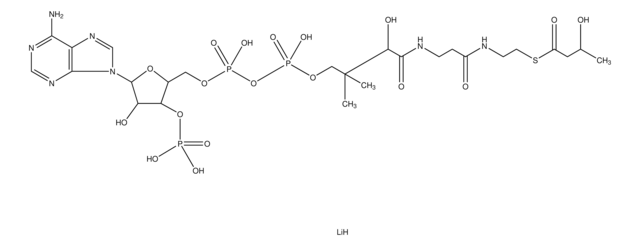S1129
Succinyl coenzyme A sodium salt
≥85%
Synonym(s):
Succinyl CoA sodium salt
About This Item
Recommended Products
Quality Level
Assay
≥85%
form
powder
solubility
water: 50 mg/mL, clear, colorless
storage temp.
−20°C
SMILES string
[Na+].[Na+].CC(C)(COP(O)(=O)OP(O)(=O)OC[C@H]1O[C@H]([C@H](O)[C@@H]1OP(O)([O-])=O)n2cnc3c(N)ncnc23)C(O)C(=O)NCCC(=O)NCCSC(=O)CCC([O-])=O
InChI
1S/C25H40N7O19P3S/c1-25(2,20(38)23(39)28-6-5-14(33)27-7-8-55-16(36)4-3-15(34)35)10-48-54(45,46)51-53(43,44)47-9-13-19(50-52(40,41)42)18(37)24(49-13)32-12-31-17-21(26)29-11-30-22(17)32/h11-13,18-20,24,37-38H,3-10H2,1-2H3,(H,27,33)(H,28,39)(H,34,35)(H,43,44)(H,45,46)(H2,26,29,30)(H2,40,41,42)/p-2/t13-,18-,19-,20?,24-/m1/s1
InChI key
VNOYUJKHFWYWIR-FZEDXVDRSA-L
Application
- for the nonenzymatic succinylation of lysine in vitro,
- as a substrate for adipic acid biosynthesis in recombinant E. coli
- in isocitrate dehydrogenase (ICDH) treatment for the succinylation of proteins
- as a substrate to study the specificity and kinetics of enzymes such as acetate:succinate CoA-transferase and 5-aminolevulinate synthase (ALA synthase)
Biochem/physiol Actions
Signal Word
Warning
Hazard Statements
Precautionary Statements
Hazard Classifications
Eye Irrit. 2 - Skin Irrit. 2 - STOT SE 3
Target Organs
Respiratory system
Storage Class Code
11 - Combustible Solids
WGK
WGK 3
Flash Point(F)
Not applicable
Flash Point(C)
Not applicable
Personal Protective Equipment
Regulatory Listings
Regulatory Listings are mainly provided for chemical products. Only limited information can be provided here for non-chemical products. No entry means none of the components are listed. It is the user’s obligation to ensure the safe and legal use of the product.
JAN Code
S1129-25MG:
S1129-10MG-KC:
S1129-5MG:
S1129-VAR:
S1129-10MG:
S1129-100MG:
S1129-BULK:
Certificates of Analysis (COA)
Search for Certificates of Analysis (COA) by entering the products Lot/Batch Number. Lot and Batch Numbers can be found on a product’s label following the words ‘Lot’ or ‘Batch’.
Already Own This Product?
Find documentation for the products that you have recently purchased in the Document Library.
Customers Also Viewed
Our team of scientists has experience in all areas of research including Life Science, Material Science, Chemical Synthesis, Chromatography, Analytical and many others.
Contact Technical Service















